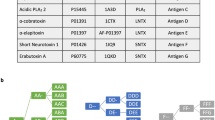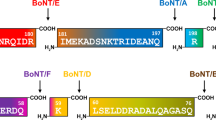Abstract
Botulinum neurotoxin (BoNT) binds to nontoxic nonhemagglutinin (NTNHA) protein in a pH-dependent manner, and yields the protease-resistant BoNT/NTNHA complex. Here, we screened short peptides that bind to the serotype D NTNHA (NTNHA-D) using random phage display technique. NTNHA was fixed onto electrode of quartz crystal microbalance (QCM) apparatus, and then the phages displaying random heptapeptides were exposed to the NTNHA-D under the acidic condition. After rinsing with acidic buffer, the released phages under the alkaline condition were collected. The binding and release of the phage were monitored by the frequency shift on the QCM. As a result of the screening, 16 were selected as peptides that bind to NTNHA-D. The selected peptides do not share any conserved sequence, but tend to be rich in basic and/or hydrophobic amino acid. This would explain the binding manner of the BoNT to the NTNHA protein.



Similar content being viewed by others
References
Li L, Singh BR (1999) Structure–function relationship of clostridial neurotoxins. J Toxicol Toxin Rev 18:95–112
Montecucco C, Schiavo G (1994) Mechanism of action of tetanus and botulinum neurotoxins. Mol Microbiol 13:1–8
Miyata K, Yoneyama T, Suzuki T, Kouguchi H, Inui K, Niwa K, Watanabe T, Ohyama T (2009) Expression and stability of the nontoxic component of the botulinum toxin complex. Biochem Biophys Res Commun 384:126–130
Niwa K, Koyama K, Inoue S-I, Suzuki T, Hasegawa K, Watanabe T, Ikeda T, Ohyama T (2007) Role of nontoxic components of serotype D botulinum toxin complex in permeation through a Caco-2 cell monolayer, a model for intestinal epithelium. FEMS Immunol Med Microbiol 49:346–352
Ohishi I, Sakaguchi G (1980) Oral toxicities of Clostridium botulinum type C and D toxins of different molecular sizes. Infect Immun 28:303–309
Gu S, Rumpel S, Zhou J, Stromeier J, Bigalke H, Perry K, Shoemaker CB, Rummel A, Jin R (2012) Botulinum neurotoxin is shielded by NTNHA in an interlocked complex. Science 335:977–981
Krumpe LRH, Atkinson AJ, Smythers GW, Kandel A, Schumacher KM, McMahon JB, Makowski L, Mori T (2006) T7 lytic phage-displayed peptide libraries exhibit less sequence bias than M13 filamentous phage-displayed peptide libraries. Proteomics 6:4210–4222
Nishiyama K, Takakusagi Y, Kusayanagi T, Matsumoto Y, Habu S, Kuramochi K, Sugawara F, Sakaguchi K, Takahashi H, Natsugari H, Kobayashi S (2009) Identification of trimannoside-recognizing peptide sequences from a T7 phage display screen using a QCM device. Bioorg Med Chem 17:195–202
Takakusagi Y, Kuroiwa Y, Sugawara F, Sakaguchi K (2008) Identification of a methotrexate-binding peptide from a T7 phage display screen using a QCM device. Bioorg Med Chem 16:7410–7414
Takakusagi Y, Takakusagi K, Kuramochi K, Kobayashi A, Sugawara F, Sakaguchi K (2007) Identification of C10 biotinylated camptothecin (CPT-10-B) binding peptides using T7 phage display screen on a QCM device. Bioorg Med Chem 15:7590–7598
Hasegawa K, Watanabe T, Sato H, Sagane Y, Mutoh S, Suzuki T, Yamano A, Kouguchi H, Takeshi K, Kamaguchi A, Fujinaga Y, Oguma K, Ohyama T (2004) Characterization of toxin complex produced by a unique strain of Clostridium botulinum serotype D 4947. Protein J 23:371–378
Author information
Authors and Affiliations
Corresponding author
Additional information
Yoshimasa Sagane, Keita Miyata and Sayuri Kurihara contributed equally to this study.
Rights and permissions
About this article
Cite this article
Sagane, Y., Miyata, K., Kurihara, S. et al. Random Phage Display-Based Screening of Peptides that Bind to Botulinum Neurotoxin Binding Protein, Nontoxic Nonhemagglutinin. Curr Microbiol 67, 188–192 (2013). https://doi.org/10.1007/s00284-013-0355-0
Received:
Accepted:
Published:
Issue Date:
DOI: https://doi.org/10.1007/s00284-013-0355-0




